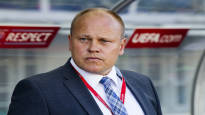This is how Mixu Paatelainen’s selections promoted Finland’s journey to the first prize competitions. The fate of the head coach was anything but an exception in the history of the Finnish A national team.
Pekka Holopainen sports reporter
Having had a great career both as a football player and as a coach Mixu Paatelainen biography The Fighting Big Finn (The Fighting Big Finn, lit. Jukka Lyytinencust. Tammi) will be published on Tuesday, August 27. When it comes to a king’s game professional who left Finland in 1987, the book is to a large extent even an archaeological exploration of how the so-called human-oriented coaching method had not quite had time to land in Scotland when Paatelainen arrived there from Valkeakoski.
Some of the descriptions of the coaching situations are chilling with the glasses and human perceptions of 2024, but Paatelainen does not emerge from between the hard covers as a representative of the type of person who cries about the harshness of the world. Even from the hellish pressure cooker of the Paris Olympic Village, he might have survived without feeling anxious at all. The Fighting Big Finn is very much a survivor biography.
In 2015, Paatelainen’s firing from the job of head coach of the A national team – and the process that already led to the firing – received an extraordinary amount of publicity. It was also influenced by the blow-by-blow style of the target of the kicks in the media’s torture chamber.
After all, we had moved on to an era when our own A national team started to mean a lot to Finns and the games were no longer primarily attended to watch big-name opponents.
The history of kicks
Although the starting passes of the most famous domestic head coach in the history of the A national team looked exceptionally rough, the recent history of the institution named 2007 Huuhjajis is above all the history of coach firings. Paatelainen was just part of an unhappy continuum.
Martti Kuusela left Palloliito in 1987, apparently in more or less good spirits; there are different views on this. Jukka Vakkila got fired Tommy Lindholm resigned before being fired, willing to continue Richard Möller-Nielsen was put on the bench against his will, Antti Muurinen got fired, as well Stuart Baxter and above all Hans Backe.
Jukka Ikäläinen, Jyrki Heliskoski and Olli Huttunen only serve as temporary locomotives for a short time.
Before Markku Kanervaa there was an exception to the rule Roy Hodgsonwho left, even though the extension offer was rejected even though the striking ability of the Pallloliito was rejected.
Hodgson, already highly meritorious internationally, went to Finland to get his sidetracked coaching career back on the bullet train tracks. It was enough that he took Finland’s then excellent player material to the end of the European Championships.
Paatelainen’s esteem in his long-time home country of Scotland was not affected by the two failed qualifiers as head coach, because success in Finland was not and is not expected in the so-called big football world.
Totally unreasonable
When you compare the absolute goal of Palloliitto for a place in the 2016 European Championships and the player material in Paatelainen’s hands, you understand the complete unreasonableness of the employer’s assignment. When Paatelainen still played with this material in a 4-3-2-1 format that was technically, tactically and time-consumingly demanding, the end result was logical.
This field arrangement, which was optimistic about the abilities of the Finnish players, started to be called by the word for which Paatelainen’s time is best remembered: Christmas tree. Through unfortunate results, the concept became a joke, with which Paatelais was beaten like a foreign pig.
He became a Christmas tree, for which the employer forgot to get decorations.
How did the 2016 EC goal, which turned out to be a total castle in the clouds, serve head coach Markku Kanerva? When you see from the side as an assistant coach how overly optimistic football is played with material that avoids international standards, only a fool would try the same thing again.
With his team that went to the European Championships in 2021, much better than Paatelainen’s period, Kanerva only did things that were within the limits of the players’ skill and other competence levels.
